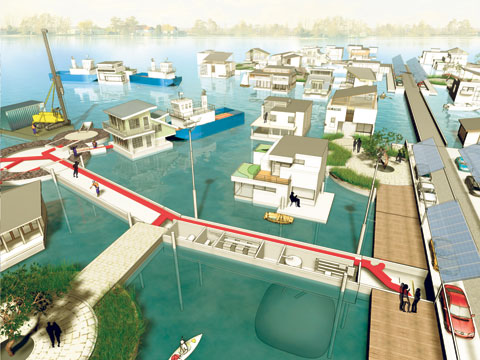The climate is changing, the end of fossil fuel stocks is in sight and more and more people live in cities. All this creates the need for different uses of resources like water. Rutger de Graaf studied options for sustainable water management in urban areas.
“Cities are parasitic; they dispose of their waste in their surroundings, and also depend on those surroundings for their base materials. With growing urbanisation, this cannot continue,” argues Rutger de Graaf, who is known for the internationally famous concept of the floating city, which he developed with TU Delft students. He now finished his PhD research, which has a broader focus: future ways of sustainable water management in cities. He will defend his thesis on November 23.
De Graaf’s research is part of a larger national project called ‘Living with water’, which focuses on changes in Dutch water management. “What is unique about this project is that scientists, companies and governmental organisations all work together. I think this is a very beneficial way of working for engineers. It helps to realize concepts you think of in practice,” De Graaf says. Most of this project’s subprojects are now in the concluding stages. In January, all the project results will be presented at a major conference.
In his thesis, De Graaf stresses the importance of making cities less vulnerable, and offers three possible solutions for doing so. One is to use water as an energy source. “In urban environments, water can be used as an energy source through heat exchange,” he explains. “The basic idea is that in the summer you extract heat from surface water and store it in the groundwater. In the winter you then use this energy to warm houses.” As part of the larger project, this idea is about to be applied to 2,800 new homes in Heerhugowaard. De Graaf used this case study to prove that the heat exchange system is economically viable and leads to a 60 percent reduction of CO2.
Another idea for sustainable water management in cities that De Graaf studied was the use of water sources within the city itself. For the same area in Heerhugowaard, De Graaf calculated that while it is indeed feasible to locally purify groundwater and surface water to make them drinkable, it is costly. A much cheaper option for reducing the need to import drinking water by up to 27 percent is to provide each home with its own rainwater tank.
Unlike the idea of using water as an energy source, this idea of making cities self-providing has not yet been tested in practice, however. De Graaf: “One of the reasons why people, like water managers aren’t interested in this idea is that they tend to think there is plenty of water in the Netherlands. But there are so many uncertainties about what climate change, as well as exhaustion of fossil fuels and growing urbanisation will bring us. Because of this uncertainty, it’s important to gather knowledge as well as experience on as many different options as possible. In neighbouring countries, such options are already being studied. In Great Britain for instance they’re discussing desalination plants that make drinking water out of sea water. And in Belgium new homes are equipped with rainwater tanks, with the residents using this water for activities that don’t necessarily require drinking water. Examples are flushing toilets, doing the laundry and watering the garden.”
And finally, the one getting all the press, the third solution De Graaf studied floating houses. “A huge advantage of these houses is that they’re highly adaptive if sea levels should rise,” De Graaf explains. “Also, in floating cities it’s much easier to incorporate ideas like using water as an energy source and making neighbourhoods self-providing when it comes to water. I don’t however think floating houses should be built everywhere; for instance, it’s not a good idea to build them in the middle of nature reserves, as this would disturb the landscape. But take an area like the Port of Rotterdam. Most of the industry in this area is being relocated to the Tweede Maasvlakte, which offers a great opportunity for expanding the housing stock within city boundaries. You could of course fill the harbour with sand and build on top of that, but why not build floating houses in it instead?”
Hoe kunnen de Australiërs zich tegen deze rampen verweren? “Zulke branden ontdek je in een groot land als Australië waarschijnlijk pas als ze groot zijn”, zegt hoogleraar veiligheidskunde prof.dr. Ben Ale van Techniek, Bestuur en Management desgevraagd. “Dan zijn ze eigenlijk niet meer tegen te houden. Het enige dat dan nog helpt is open grond die niet kan branden. Als je je huis wilt beschermen moet je ervoor zorgen dat je een lege vlakte tussen je huis en de dichtstbijzijnde bossen hebt. Wat ook helpt zijn spraysystemen; een soort watergordijn in je tuin. Dat werkt zo lang de waterleiding werkt. Bij gebeurtenissen op deze schaal gaat dat snel fout. Verder is het gewoon over. Jammer.”
De branden in Australië doen prof.ir. Kees van Weeren van de leerstoel ontwerpen van draagconstructies (Bouwkunde) denken aan het vuur dat tijdens de Tweede Wereldoorlog Dresden in de as legde. “Het is een enorme vuurbol van 1100 graden die langs raast. Daar is geen realistisch huis tegen bestand”, zegt hij desgevraagd.
Zijn er dan geen materialen die tegen die hitte bestand zijn? “Ja, dat wel”, zegt Van Weeren. “In de ruimtevaart worden zulke materialen gebruikt. En de petrochemische industrie kent controlegebouwtjes die brand- en explosiebestendig zijn. Vanuit die huisjes wordt de fabriek aangestuurd bij calamiteiten.” Maar van die materialen maak je geen huis, aldus de hoogleraar. Dat is veel te duur. En een veranda kun je ook op je buik schrijven. “Je hebt hoogstens piepkleine raampjes.”
Mocht van Weeren zelf ooit in een brandgevaarlijk gebied komen te wonen, dan zou hij, zoals zijn collega Ben Ale ook bepleit, zoveel mogelijk afstand houden tussen zijn huis en de omringende bomen. “En wat ook helpt”, zegt hij, “is Hollandse netheid rond het huis. Dus geen brandbare dingen laten rondslingeren.” Op het dak zou hij golfplaat leggen of dakpannen. “Dat brandt niet als er vonken op terecht komen. En ik zou geen plastic dakgoten nemen, want die branden wel weer heel gemakkelijk.”
“Een schuilkelder? Ja, dat is ook denkbaar”, zegt Van Weeren. “Maar evacuatie als daar voldoende tijd voor is, lijkt me heel wat veiliger. Zo’n schuilplaats zou bescherming kunnen bieden tegen hitte door hem bijvoorbeeld te bedekken met een laag grond van minstens een meter dik. Ook moet je zorgen voor voldoende eigen luchtvoorziening, voor het geval er een vuurstorm overheen trekt die alle zuurstof uit de lucht verbruikt.”
Volgens Ale neemt de kans op zulke natuurrampen toe als gevolg van de klimaatverandering. “Hoe hoger de temperaturen worden, hoe meer de bossen uitdrogen. Dat is niet alleen in Victoria zo, maar ook in andere gebieden waar woonbebouwing en bossen dicht bij elkaar liggen zoals in Florida. Daar is de urban-wildlife interface zoals dat heet heel erg smal is. Daar krijg je steeds meer problemen met bosbrand. Aan de andere kant krijg je ook steeds meer problemen met overstromingen. We moeten er gewoon rekening mee houden dat natuurrampen groter worden en vaker gaan voorkomen. Treurig, maar het is niet anders.”



Comments are closed.